Botswana National Parks, Game Reserves and Safaris
(Botswana, BW, Southern Africa)
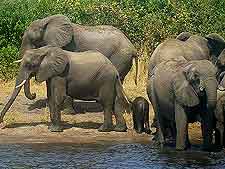
Botswana is something of a rarity. It is perhaps one of the last places in Africa where animals can roam freely in a vast landscape that is largely undisturbed by modern day developments. The plentiful national parks and nature reserves in Botswana play a key role in making sure that its wildlife environment remains second to none.
Visitors on safari in Botswana's national parks can marvel at a vast variety of animal and bird species that are indigenous to southern Africa, whilst also admiring the beautiful countryside in which they live. The hot summer season is when game viewing is at its best in this part of Africa and tends to attract the largest visitor numbers.
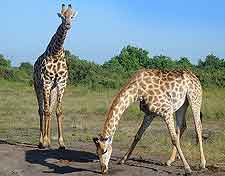
Chobe National Park
Located in the north-east of Botswana, Chobe National Park is said to have more game per square mile than any other African country. Created in 1967, the second-largest park in the entire country offers a fascinating insight into several different ecosystems. On the Chobe riverfront, visitors can look out for elephants and buffaloes in search of water during the dry season. Indeed, the park is home to over 100,000 African elephants. In the Savuti Marsh, to the west, it may be possible to catch a glimpse of warthogs, wildebeests and zebras. In the north-west of the park, lions, leopards, hippopotamuses and crocodiles roam in abundance.
Open hours: daily
Admission: charge
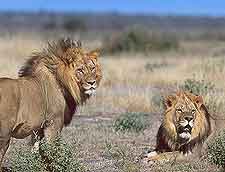
Central Kalahari Game Reserve
The Central Kalahari Game Reserve is vast. However, most of its animals can be found in the region around its northern boundary. Game-spotting opportunities include giraffes, lions and leopards, eland and springbok. The reserve is also a great place for bird spotters, with eagles, falcons, kestrels and kites regularly taking to the skies.
The landscape is a mixture of vast plains, dried-up riverbeds and salt pans. Whilst the reserve is open all year round, the best time to visit is from October to November (early summer), when many animals gather round water holes. The Central Kalahari Game Reserve can be entered via Khutse in the south, Xade in the west or Matswere in the north-east.
Open hours: daily
Admission: charge
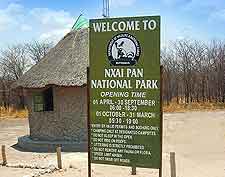
Nxai Pan National Park
Nxai Pan National Park is situated nearby another of Botswana's parks at Makgadikgadi. An easily accessible water hole near the park's entrance offers visitors a great opportunity to see giraffe, lions, impala and ostriches as they come to drink. During the wet season, the park truly springs into life, with elephants, springbok and zebra all adding to the safari experience. Within the Nxai Pan National Park are the
Baines Baobabs, a well-known tourist attraction in Botswana.
Open hours: daily
Admission: charge
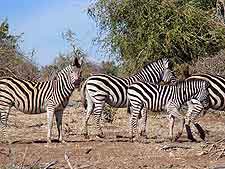
Makgadikgadi Pans National Park
Makgadikgadi's vast empty landscape has never been populated because of its almost constant waterless state. Set up in 1970, Makgadikgadi finally became one of Botswana's National Parks in 1992. The dramatic migrations of wildebeest and zebras as they flock to the pans in the south-east and north-east of the park during the wet season make for a spectacular sight. Visitors can opt to take to the air to get a better view.
Open hours: daily
Admission: charge
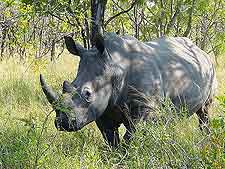
Mokolodi Nature Reserve
Tel: +267 316 1955
With Gaborone just a short drive away, the Mokolodi Nature Reserve is a popular tourist destination. A variety of activities are available, including guided walks through the bush, giraffe and rhino tracking, and night drives. As well offering visitors an opportunity to view indigenous animal species, the reserve runs a number of projects to encourage sustainability and animal protection. In particular, the Mokolodi Nature Reserve is home to some of the country's few remaining white rhinos.
Open hours: daily - 07:30 to 18:00
Admission: charge
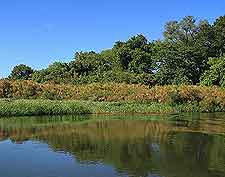
Okavango Delta / Moremi Game Reserve
Okavango Delta rates as one of the largest inland waterways in the world. The Delta's annual floods maintain a rich habitat for wildlife and bird species. Indeed, the best time to visit is during the wet season, from November through to April. Then, plants burst into full flower, and birds and animals flock into the newly flooded area. There are many ways of viewing the Okavango Delta, including taking to the water in a canoe known as a 'mokoro' or on an elephant-back tour. Of note, the Moremi Game Reserve is considered to be a part of the Okavango Delta and covers more than 1,160 square miles / 3,000 square kilometres, being known for its wildlife conservation work.
Open hours: daily
Admission: charge
 Botswana is something of a rarity. It is perhaps one of the last places in Africa where animals can roam freely in a vast landscape that is largely undisturbed by modern day developments. The plentiful national parks and nature reserves in Botswana play a key role in making sure that its wildlife environment remains second to none.
Botswana is something of a rarity. It is perhaps one of the last places in Africa where animals can roam freely in a vast landscape that is largely undisturbed by modern day developments. The plentiful national parks and nature reserves in Botswana play a key role in making sure that its wildlife environment remains second to none.




